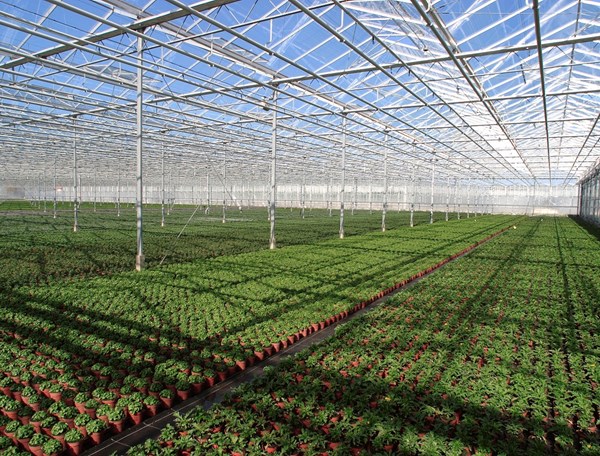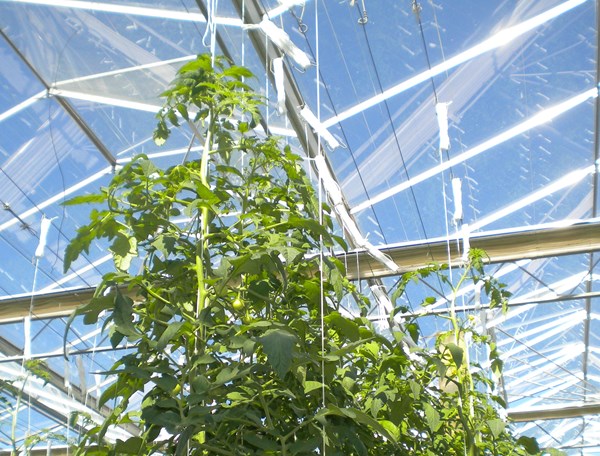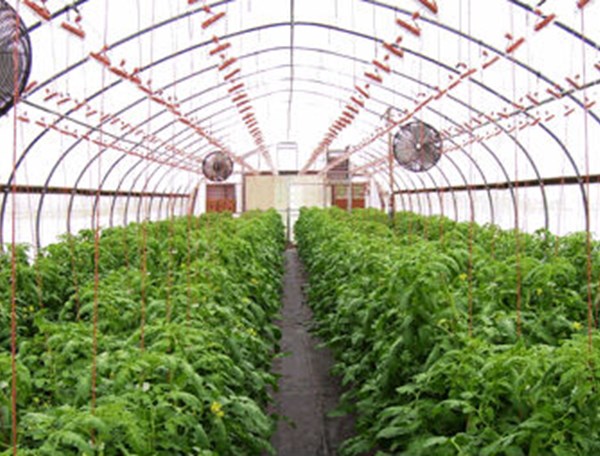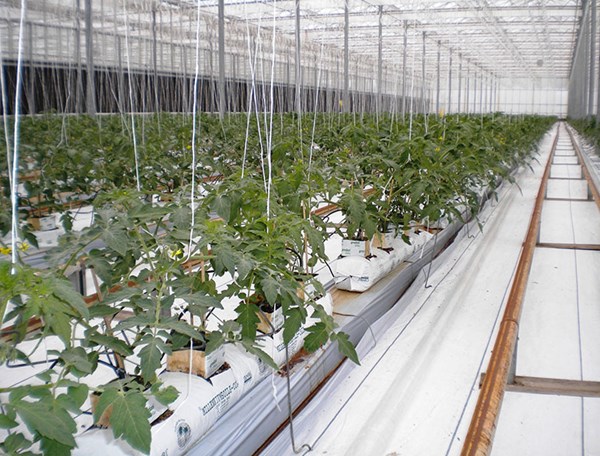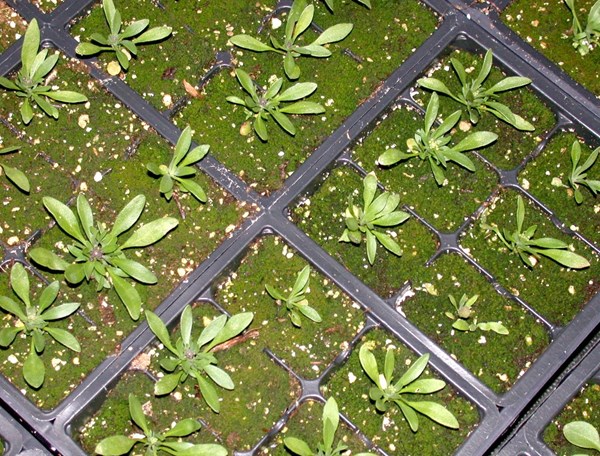Training Center
Avoiding Root Disease in Greenhouse Vegetables
Thursday, September 7, 2023 | Troy Buechel
PDF version of this text: Avoiding Root Disease in Greenhouse Vegetables
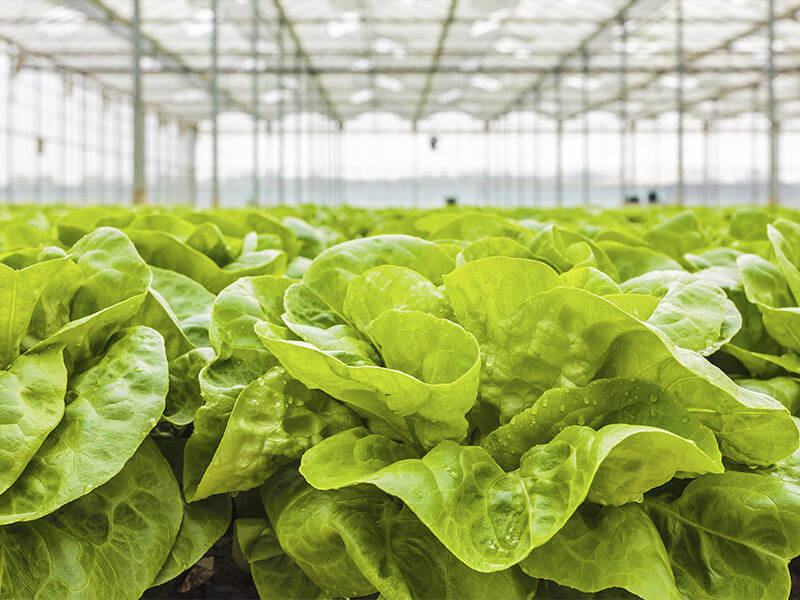
Pathogens are always present in the greenhouse and are a continuous challenge for greenhouse vegetable and herb growers. The combination of plant material, moisture and certain environmental conditions can favor plant root diseases.
In some cases, high fertilizer levels predispose plants to pathogenic fungi. This is especially true for vegetables and herbs with longer growth cycles which are constantly challenged with soil-borne diseases and insects that may vector these diseases.
What are The Causes?
Abiotic (non-living) causes that can lead to root diseases include excessive soluble salts, ammonium toxicity and suffocation. When excessive salts accumulate in the growing medium, they desiccate and kill root tips which then serve as entry points for root diseases.
Ammonium toxicity occurs when plants take up excess ammonium that accumulates in the growing medium when it is cold and wet, has a low pH and/or has insufficient air porosity. Similarly, if the growing medium has too many fine particles that fill air spaces, there is insufficient air available for the roots. Roots are under stress, making them an easy target for pathogens that thrive in these conditions.
What are The Symptoms of Root Diseases?
Eventually all vegetable plants suffering from root diseases will wilt, but before that occurs, periodically check the root system for any disease so it can be identified before it is too advanced to control. Healthy roots are generally white and firm, whereas decaying roots may appear water-soaked and brown. Some pathogens infect the roots and then move into the stem causing canker or black leg.
Which Organisms Cause Root Diseases?
Pythium is one of the most common pathogens of vegetable plants that causes damping-off, crown and stem rot. Pythium attacks vegetables that are under stress from excessive nutrient levels (high E.C.), ammonium toxicity and/or wet growing medium. It is a natural inhabitant of the soil where it can survive indefinitely; therefore, it can persist in soil and debris in the greenhouse for many years.
Introduction of Pythium into the greenhouse can occur through plug transplants, reused growing media and irrigation water. Like many pathogens, Pythium can develop resistance to fungicides. Prevention of this disease requires good sanitation practices to disinfect floors, benches and containers. Pythium can be bound to mineral soil, organic matter and its spores do not disperse with air.
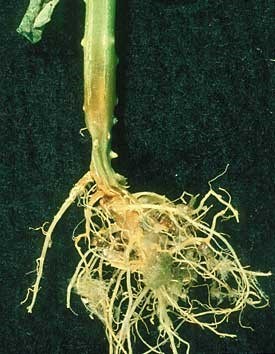
Pythium crown and root rot in greenhouse cucumber. Source: www.agf.gov.bc.ca/cropprot/pythium.htm
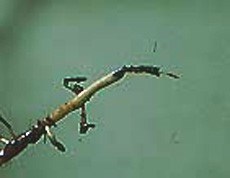
Root browning and rot caused by Pythium.
Phytophthora is a pathogen similar to Pythium; however, it is more virulent but less encountered in greenhouse vegetable crops. This pathogen causes root and crown rot as well as foliar blights. Conditions that are conducive to Phytophthora are similar to those for Pythium, excess moisture and luxury nitrogen application.
They are host specific and are generally introduced from plant material. Prevention is the key to managing Phytophthora because the pathogen is difficult to suppress with fungicides. If fungicides are used, make sure they are specifically labelled for Phytophthora as most broad-spectrum fungicides have limited control with this disease.
Rhizoctonia is also a common pathogen of greenhouse vegetables as it can cause damping-off, root and crown rot, web blight and stem canker in numerous greenhouse-grown crops.
Unlike Pythium and Phytophtora, dry soil is more favorable for disease development and it is most active in the upper portion of the growing medium.
This disease is mostly a problem in cuttings and young transplants. Root feeding insects create wounds that serve as potential entry points for this pathogen.
Thielaviopsis root and stem rot, often called black root rot, is another pathogen found in greenhouse vegetables. When it attacks plant roots, it produces many black spores within the infected parts giving them a black appearance.
Like Pythium, Thielaviopsis thrives in wet, cold growing media. It prefers a pH of 6.0 or higher in the growing medium; so Thielaviopsis can be suppressed if the pH of the growing medium is maintained at 5.5.
How to Prevent Root Diseases in Greenhouse Vegetables?
Proper sanitation and maintaining proper pH and E.C. of the growing medium are a good start in preventing root diseases. Use a growing medium that is ideal for the environment in the greenhouse. For fall and winter crops, when evapo-transpiration is low, use a growing medium with good porosity, like PRO-MIX* HP.
Even better is including active ingredients such as BIOFUNGICIDE™* or BIOFUNGICIDE™* + MYCORRHIZAE™ as BIOFUNGICIDE™ helps suppress root diseases caused by Pythium, Fusarium and Rhizoctonia, and MYCORRHIZAE™ helps improve plant health, thus resistance to an outbreak of disease.
Air temperature must be adapted for the needs of greenhouse vegetable crops, and ventilation needs to be used to reduce humidity and condensation which aid in root disease problems. Fungus gnats and shore flies may introduce and spread root rot pathogens.
If they are present, use biological or chemical controls to reduce their populations. If a vegetable crop has a root disease, it must be diagnosed by an independent laboratory so the proper control method can be used to control the spread of the disease.
In short, how to prevent root zone problems:
- Use proper sanitation before, during and after each crop cycle.
- Avoid excessive humidity in the air and encourage air flow.
- Allow growing medium to dry out and avoid overwatering, especially when cool.
- Adapt fertilization and irrigation frequency to plant needs and to the environment (overcast skies, cold temperature, and reduced sunlight are all conducive to diseases in plants).
- Use growing media that will be compatible with the plant’s needs (not too many fines in the media).
- Monitor pH and EC on a regular basis.
- Use preventive measures to control insects and diseases in the growing medium.
For more information, contact your Premier Tech Grower Services Representative:
 |
 |
 |
 |
|---|---|---|---|
|
Ed Bloodnick |
Nathan Wallace-Springer |
Lance Lawson |
Victor Brantly |
 |
 |
 |
|
|
Troy Buechel |
Susan Parent |
Jose Chen Lopez |
References:
- Robert L. Wick. 2014 "Root diseases of Greenhouse Crops" U Mass Amherst Greenhouse Crops and Floriculture Program.
- Siva Sabaratnam and Iris Bitterlich. March 2012 "Pythium disease of greenhouse vegetable crops" BC Agriculture pest management.
*BIOFUNGICIDE™ is only available in the United States. For more information, ask your Sales Representative.
PRO-MIX® is a registered trademark of PREMIER HORTICULTURE Ltd.
Related Articles
-
Greenhouse Herb and Vegetable Production – Part 1/4 - Location
In this four-part series, we will look at the ideal location, structures and environment needed to grow vegetables and herbs in a greenhouse production facility. In this first part, we will discuss the first step: finding the ideal location to start a greenhouse production facility.
-
Greenhouse Herb and Vegetable Production – Part 2/4 – Greenhouse Structure
In this second part of our four-part series on growing vegetables and herbs in the greenhouse, we will focus on the greenhouse structures needed to produce quality crops.
-
Greenhouse Herb and Vegetable Production – Part 3/4 – Greenhouse Environment
In this third part of our series on growing greenhouse vegetables and herbs we will focus on the ideal greenhouse environment.
-
Greenhouse Herb and Vegetable Production – Part 4/4 – Growing Media
In this fourth and last part of our series on growing greenhouse vegetables and herbs, we will address the appropriate growing medium to use.
-
Controlling Algae on Growing Media
It is not uncommon for most growers to find "green slime" growing on the surface of a growing medium. The following article will help you get rid of this problem.

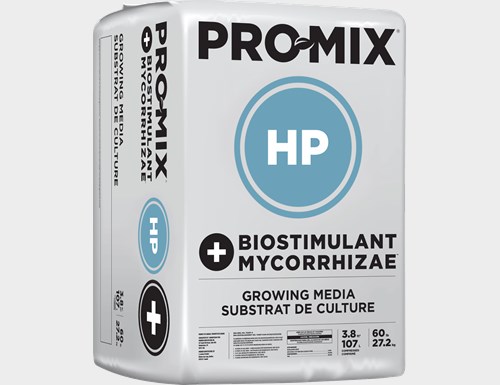
 Where to find our products
Where to find our products
